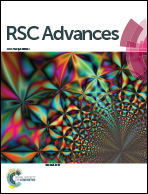Computational design to improve catalytic activity of cephalosporin C acylase from Pseudomonas strain N176†
Abstract
Engineering enzymes with high catalytic activities using enzyme design in silico and a limited number of experimental evaluations is the new trend for the discovery of highly efficient biocatalysts. In this report, a double mutant (M31βF/H70βS) cephalosporin C acylase from the Pseudomonas strain N176 was used as the starting template, and a computational enzyme design strategy aided the identification of a quadruple mutant (M31βF/H70βS/F58βN/I176βT) that exhibited a 2.7-fold increase in catalytic efficiency (Vmax/Km) when compared with that of the template. The time-course results confirmed that the quadruple mutant was a promising enzyme to catalyze the hydrolysis of cephalosporin C to produce 7-amino cephalosporanic acid in one-step under industrial conditions.



 Please wait while we load your content...
Please wait while we load your content...